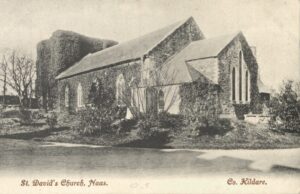Naas and Saint David (by John Walsh)

Our thanks to John Walsh for submitting the piece below on the connections between the town of Naas and Saint David.
St. David’s association with Naas can be traced back to Norman times. In 1156 the King Of Leinster Dermot McMurrough was at war with the chieftains of Breffni and Meath and sought assistance from Baron Richard de Clare, Earl of Strigul. Richard was known to the Irish as Strongbow and in 1170 he set out for Ireland from Wales with a contingent of 300 Norman Welsh Knights.
Strongbow took control of Leinster and married Aoife, a daughter of Dermot’s. The confiscation of lands then commenced in order to reward his knights and to finance the campaign. The Barony of Naas and about 25,000 acres was granted to Maurice FitzGerald from the St. David’s area of Pembrokeshire in South Wales and from that time Naas came under the patronage of Saint David. Maurice’s brother David FitzGerald was Bishop of St. David’s from 1147 to 1176. Both Maurice and David were sons of Nesta and Gerald de Windsor. The grant was confirmed to his son, William FitzMaurice (Lord of Naas), by Henry II in 1177 and reconfirmed by Prince John in 1185.
“I John, son of the King Of England and Lord of Ireland, to all his men and faithful French, English and Irish, greetings: Know ye that I have granted and by this my present charter confirmed to W. FitzMaurice, and his heirs, one cantred of land which Makellan held, in which is situate the town of Naas and which Earl Richard gave to Morice, father of the said William, to be held of the heirs of Earl Richard by the service of five knights: Wherefore I will firmly order the said William and his heirs, after him, may hold well and in peace, freely, wholly, fully, honourably and peaceably, all the aforesaid land, and its appurtenances in land and sea, its woods and plains, its castles, fortresses, its boroughs and towns, its churches and chapels; and I have granted to him a market at his borough of Naas every Saturday weekly. Also I have granted him sac and soc and toll ant them, infang thef, ponethef, judgement of water, and iron, and the duel, the pit, the gallows and all other liberties and free customs which belong to the same land, except the pleas, appertaining to the Royal Crown, which I retain for my own use.” Witness; Bertram de Veredun, Seneschal, at Kildare.
The Anglo-Normans made many changes to Naas. The town was fortified by walls, gates and castles, including St. David’s Castle (known locally as King John’s Castle as King John is said to have held parliaments or meetings there in 1206 and 1210).
The parish church, which was originally dedicated to St. Patrick and to St. Corban was rebuilt and re-dedicated to St. David. Those Anglo Norman Barons renamed many of the Irish town lands in the Naas area and many of these names have survived to this day – Kerdiffstown (after Cardiff), Nunsland after St. Non (mother of St. David), Brannockstown (town of the Welshmen), Punchestown (after Puncheston) and Davidstown.
St. David’s Day was celebrated for centuries in Naas and this custom continued up to the close of the 18th century where it was the custom to wear a green leek in honour of St. David on the 1 March of each year.
An account from 1577 record the following – “Rori Oge O’More and Cormacke MacCormacke O’Connor accompanied with more than 140 men and boys burned between 700 and 800 houses in the market town called the Naas. They ran through the town being open like haggs and furies often with flakes of fire fastened on pole ends and so fired the low thatched houses and it being a great windy night one house took fire of another in a moment, they tarried not half an hour in the town. There was about five hundred men’s bodies in the town, manly enough in appearance, but neither manful nor wakeful as it seemed, for they confessed thy were all asleep in their beds after they had filled themselves and surfeited on their Patron’s St David’s Day, which day is celebrated for the most part of the people of this country birth with gluttony and idolatry as far as they dare”
The town’s link to St. David continues through a wide variety of names such as – St. David’s School, St. David’s Terrace, The Church of Our Lady and St. David and St. David’s Boxing Club. The formal twinning of St. David’s and Naas took place on 6 March 1992 and with Naas with St. David’s on 13 March 1993.
